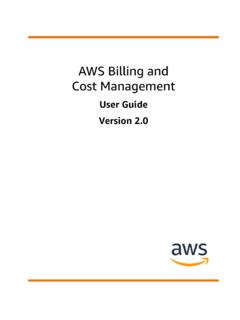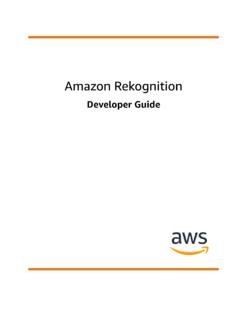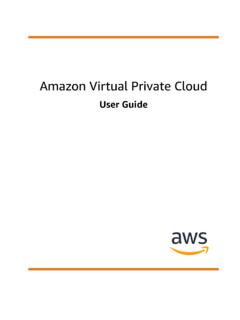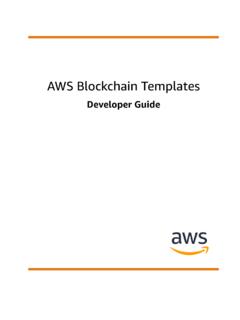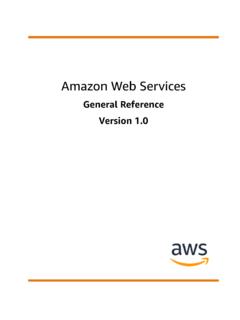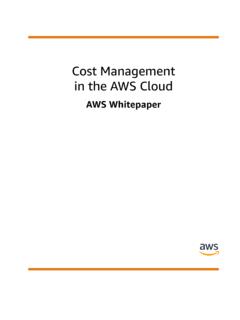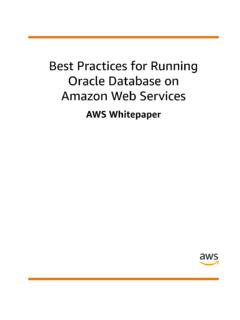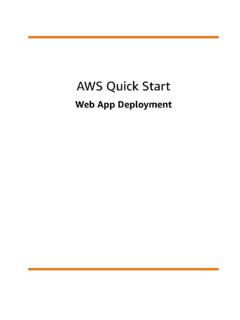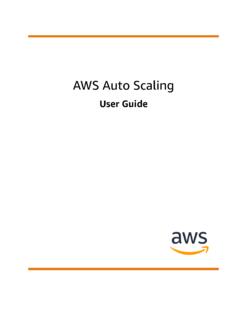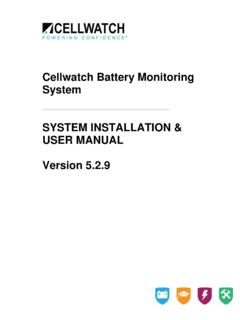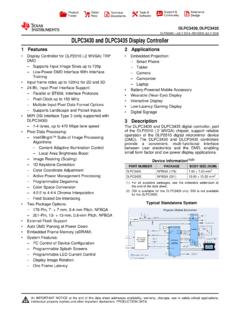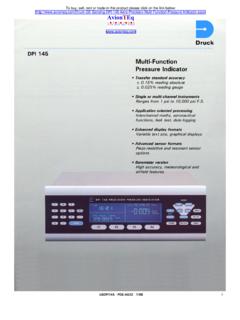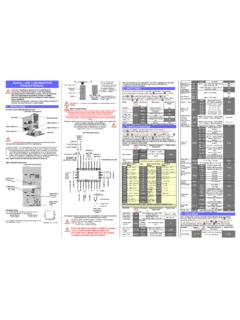Transcription of Application Auto Scaling - User Guide - AWS Documentation
1 Application auto ScalingUser GuideApplication auto Scaling user GuideApplication auto Scaling : user GuideCopyright 2019 Amazon Web Services, Inc. and/or its affiliates. All rights 's trademarks and trade dress may not be used in connection with any product or service that is not Amazon's, in any mannerthat is likely to cause confusion among customers, or in any manner that disparages or discredits Amazon. All other trademarks notowned by Amazon are the property of their respective owners, who may or may not be affiliated with, connected to, or sponsored auto Scaling user GuideTable of ContentsWhat Is Application auto Scaling ?
2 1 Features of Application auto Scaling .. 1 Getting Started .. 1 Accessing Application auto Scaling .. 2 Target Tracking Scaling Policies .. 3 Considerations.. 3 Cooldown Period .. 4 Create a Target Tracking Scaling Policy .. 4 Describe Target Tracking Scaling Policies .. 5 Delete a Target Tracking Scaling Policy .. 6 Step Scaling Policies .. 7 Scaling Adjustment Types .. 7 Step Adjustments .. 8 Cooldown Period .. 9 Create a Step Scaling Policy.
3 9 Describe Step Scaling Policies .. 10 Delete a Step Scaling Policy .. 11 Scheduled Scaling .. 12 Create a Scheduled Action .. 12 Describe Scheduled Actions .. 12 Delete a Scheduled Action .. 13 Authentication and Access Control .. 14 Specifying Actions in a Policy .. 14 Specifying the Resource .. 15 Specifying Conditions in a Policy .. 15 Example Policies .. 15 Additional IAM Permissions .. 16 Service-Linked Roles .. 17 Permissions Granted by the Service-Linked Roles.
4 18 Create Service-Linked Roles (Automatic) .. 19 Create Service-Linked Roles (Manual) .. 20 Edit the Service-Linked Roles .. 20 Delete the Service-Linked Roles .. 20 Supported Regions for Application auto Scaling Service-Linked Roles .. 20 Limits.. 21 Document History .. 22iiiApplication auto Scaling user GuideFeatures of Application auto ScalingWhat Is Application auto Scaling ? Application auto Scaling allows you to configure automatic Scaling for the following resources: Amazon ECS services Spot Fleet requests Amazon EMR clusters AppStream fleets DynamoDB tables and global secondary indexes Aurora replicas Amazon SageMaker endpoint variants Custom resources provided by your own applications or services.
5 For more information, see the have several options for Scaling with AWS. For information about Scaling your fleet of Amazon EC2instances, see the Amazon EC2 auto Scaling user can also use Application auto Scaling and Amazon EC2 auto Scaling in combination with AWS AutoScaling to scale resources across multiple services. For more information, see the AWS auto Scaling of Application auto ScalingApplication auto Scaling allows you to automatically scale your scalable resources according toconditions that you define.
6 Target tracking Scaling Scale a resource based on a target value for a specific CloudWatch metric. Step Scaling Scale a resource based on a set of Scaling adjustments that vary based on the size ofthe alarm breach. Scheduled Scaling Scale a resource based on the date and StartedTo learn more about the AWS services supported by Application auto Scaling , see the followingdocumentation: Service auto Scaling in the Amazon Elastic Container Service Developer Guide Automatic Scaling for Spot Fleet in the Amazon EC2 user Guide Using Automatic Scaling in Amazon EMR in the Amazon EMR Management Guide Fleet auto Scaling for AppStream in the Amazon AppStream Developer Guide Managing Throughput Capacity with DynamoDB auto Scaling in the Amazon DynamoDB DeveloperGuide Using Amazon Aurora auto Scaling with Aurora Replicas in the Amazon RDS user Guide Automatically Scaling Amazon
7 SageMaker Models in the Amazon SageMaker Developer Guide1 Application auto Scaling user GuideAccessing Application auto ScalingFor information about AWS auto Scaling , see the AWS auto Scaling user Guide . The AWS auto Scalingconsole is where the Scaling features of individual services come together in a single user see the regional availability for any of the AWS services listed above, see the AWS Region Application auto ScalingIf you've signed up for an AWS account, access Application auto Scaling by signing into the AWSM anagement Console.
8 Then, open the service console for one of the services listed in the Getting can also access Application auto Scaling using the Application auto Scaling API. Application AutoScaling provides a Query API. These requests are HTTP or HTTPS requests that use the HTTP verbs GETor POST and a Query parameter named Action. For more information, see Actions in the ApplicationAuto Scaling API you prefer to build applications using language-specific APIs instead of submitting a request overHTTP or HTTPS, AWS provides libraries, sample code, tutorials, and other resources for softwaredevelopers.
9 These libraries provide basic functions that automate tasks such as cryptographically signingyour requests, retrying requests, and handling error responses, making it is easier for you to get more information, see AWS SDKs and you prefer to use a command line interface, you have the following options:AWS Command Line Interface (AWS CLI)Provides commands for a broad set of AWS products, and is supported on Windows, macOS, andLinux. To get started, see AWS Command Line Interface user Guide . For more information, seeapplication-autoscaling in the AWS CLI Command Tools for Windows PowerShellProvides commands for a broad set of AWS products for those who script in the PowerShellenvironment.
10 To get started, see the AWS Tools for Windows PowerShell user Guide . For moreinformation, see the AWS Tools for PowerShell Cmdlet information about your credentials for accessing AWS, see AWS Security Credentials in the AmazonWeb Services General Reference. For information about regions and endpoints for calls to ApplicationAuto Scaling , visit AWS Regions and Endpoints in the AWS General auto Scaling user GuideConsiderationsTarget Tracking Scaling Policies forApplication auto ScalingWith target tracking Scaling policies, you select a predefined metric or configure a customized metric,and set a target value.
